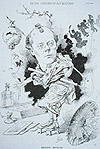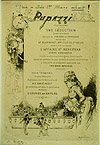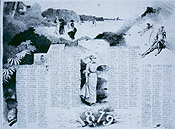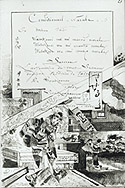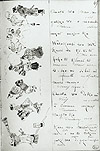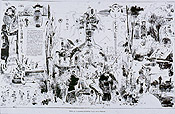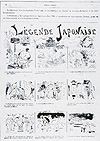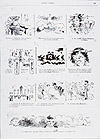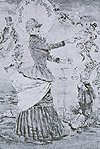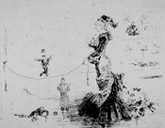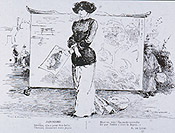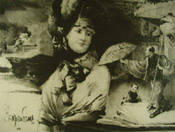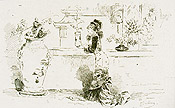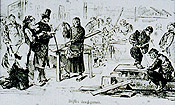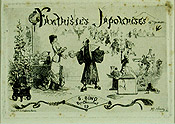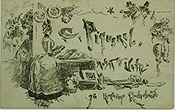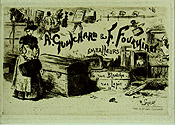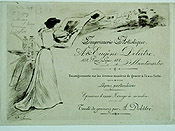The browser will either open the file, download it, or display a dialog.
|
|
The Functional Print in Commercial Culture: Henry Somm's Women in the Marketplace |
||||||||||||
|
Japonisme, a term invented by the art critic Philippe Burty in 1872, developed in response to an appreciation of the art and culture of Japan. The flow of prints and art objects from Japan to Europe affected not only progressive artists such as Claude Monet, Vincent van Gogh, or Toulouse-Lautrec, but also academic genre painters including James Tissot and Alfred Stevens. The former attempted to change the way the surface of the painting looked, while the latter were more interested in the intrinsic value of Japanese objects and how they could add a degree of sophistication and diversion to contemporary homes, thus changing the very nature of European bourgeois society's interiors. | ||||||||||||
| François-Clement Sommier (1844-1907), better known as Henry Somm, was central to the Japonist movement as he watched this phenomenon evolve from an amusing divertissement to a veritable passion that dominated almost every aspect of middle-class existence. His prints and drawings suggest that women were the primary consumers of Japanese art objects marketed by Siegfried Bing and others in the last quarter of the nineteenth century. Critical to our understanding of the emergence of Japonisme as a mainstay of fine and popular culture of the second half of the nineteenth century is a careful study of the prints that advertise the movement. This essay provides a context for the interpretation of what we shall call "functional prints"—prints used for a practical as well as a symbolic function. | |||||||||||||
| An examination of a selection of Somm's works demonstrates his discovery, assimilation, and eventually criticism, of the phenomenon of Japonisme. He illustrates each of these three phases in works that mimic advertisements, but were produced as fine art limited edition prints. Each phase similarly shows how women—who held a central role in Somm's imagery—were also inextricably bound to the Japonist phenomenon, as consumers, and agents of promotion, or both. | |||||||||||||
| HENRY SOMM AND POPULAR JOURNAL ILLUSTRATION Henry Somm is perhaps best known as a "minor Impressionist," but a more appropriate description is as a transitional artist between Impressionism and Symbolism.1 His work for illustrated journals over a twenty year period combines comments on fashion, feminism and a type of romantic orientalism. Unfortunately, the private life of Henry Somm remains a mystery. Articles written during the artist's lifetime, some even written by close friends, fail to shed light on his personal nature; and a complete chronology of his life cannot be reconstructed.2 Somm's articles and short stories similarly fail to reveal anything about him personally.3 In the absence of documents clarifying any personal motives, we must rely on the content of the images themselves and deduce any deeper meaning from an understanding of the cultural and historical context in which they were created. This is especially true for images that reference a relationship with Siegfried Bing. |
|||||||||||||
| J. Lemot (1847-1909), known as Uzès, depicted Henry Somm in the popular journal Le Courrier français in 1885 (fig. 1). It shows the artist in a top-knot and dressed in a Japanese kimono, alluding to the increased importance of Japonisme.4 Included in the illustration are other aspects of Somm's favored iconography, such as a string of figures in silhouette that refer to Somm's participation in the Chat Noir shadow theater. In 1886, Henry Somm's The Elephant became the first théâtre d'ombre production at the Chat Noir, one of the most popular avant-garde sites in Montmartre. The silhouetted figures, in the shadow play design, also document Somm's interest in Japan in general, a point communicated by the umbrella, the lantern, and the branch used to represent early spring in traditional Japanese images where the silhouette is often a popular visual conceit. | |||||||||||||
| Another element in Uzès's print is the small figure of a fashionably dressed Parisian woman who, because of her scale and her placement in the artist's palm, is under Somm's control. The engraving tools, found under Somm's belt, and the chemicals used in the printmaking process at the lower left (specifically nitric acid) further suggest that this type of woman has been "fashioned" or "invented" by the artist at the same time that he is working on the print process. Of course, in the traditional sense of artist-as-creator, Somm is literally in control of the content of his prints, be it fashionable women, Japanese ephemera, or an Impressionist landscape. But the proportions of the figures presented by Uzès reverse the typical male/female scale relationships found throughout Somm's oeuvre. | |||||||||||||
|
The more typical scale relationship is demonstrated in Somm's Pupazzi—where the fashionable woman dominates male figures who now resemble puppets or dolls (fig. 2). The men are crowded into an acid bath for etchings, dominated by a fashionably clad Amazon who has a burin and a scraper dangling from her sleeve. Pupazzi takes the form of a menu or program for a performance that seems never to have taken place. What is critical to understand is that in prints such as this, Somm appears responsible for both the written and visual content, as opposed to merely providing an illustration for someone else's material.5 In inventing both the nature of the fantasy performance and the illustration for it, Somm demonstrates a role he played in his work as a writer/illustrator for popular journals. From his earliest work for La Chronique parisienne to his contributions to Le Rire at the end of his life, Somm was responsible for both the images and the captions; it is also likely that, at least part of the time, he was the author of the text.6 | ||||||||||||
|
A functional form of printmaking—a type of advertising structure—is now merged with the limited impression etching method, the very method being demonstrated visually in Pupazzi. Through his positioning of the woman in a role of control over minions, Somm cleverly links the corrosive etching process with the seduction of men by powerful and often evil women. The story of Orpheus being dismembered by the Maenads after his ill-fated marriage to Eurydice (alluded to in the verbal content of the menu) enriches the imagery utilized by Somm.7 The Greek myth leaves unresolved the issue of the good versus the evil woman, since Orpheus was essentially destroyed by both types. In referring to this myth, Somm also alludes to the idea that the passion that men feel for seemingly innocent women is a fundamental weakness. The drypoint/etching Pupazzi documents or advertises, therefore, not a particular performance but rather a situation, thus blurring the line between popular culture and fine art. The print takes on a hybrid function: it is used not in the traditional popular culture sense of mass-produced imagery in popular journals but as fine art with permanence masquerading as a transient object whose real value would be lost once the date of the performance it documents has passed. A similar phenomenon exists in the many calendars produced by Somm during this period (fig. 3). The etching/drypoint method limits the numbers to be printed, making what should be a widely-available, and soon irrelevant, content ironically valuable and collectible through the rarity of the available print. Curiously, in many of these calendars, fashionable women and Japanese elements are combined, and Japonisme—the taste for things Japanese—is documented as happening chronologically. |
|||||||||||||
|
THE TASTE FOR THINGS JAPANESE |
||||||||||||
|
To put his two years of study into practice, Somm planned a trip to Japan in 1870, but was prevented from undertaking it due to the Franco-Prussian war. He published a commentary in the October 7, 1871 issue of High-Life. In a rebus, Somm claimed to represent the political situation in France through the eyes of a Japanese; actually himself (fig. 6). This work documented not only an interest in Japan, but also Henry Somm's frustration at having his voyage cancelled. The power of the rebus was enhanced by its placement within the journal—it followed a reprint of Adolphe Thier's (1797-1877) letter declaring war. | ||||||||||||
|
The text that appears on the scroll at left tells us we should be particularly concerned with the content of the vase, said to contain disagreeable things:
While the scene appears to take place in Japan, the appearance on the right in silhouette of a Parisian kiosk, along with the Parisian woman on the fan at right, reminds us that this scene takes place in France. The positioning of the pipe, in between two visual references to Paris, suggests that the entire scene may also be a hallucination. If so, the image reinforces one of the principal ways in which Somm, and others, saw Japonisme at the time—as an extension of Romanticism. |
|||||||||||||
| The imagery included in the rebus is intentionally complex and circular in its logic. For this reason it is not possible to ascribe to it a concrete meaning. Reading from right to left, the way a Japanese painting is viewed and the way that this illustration is presented, we see first the references to Paris and an opium-induced hallucination. As one of the earliest images by Somm to include stereotypical forms that he would use in a wide range of other works, Somm was in the vanguard of those illustrators and writers who were constructing an imaginative response to Japan as a means of attracting a public following. In the center, a group of Japanese men view a huge ceramic jar that appears to function as a signboard. The main figure on the jar appears as a Japanese jester, who also resembles Somm, complete with a geisha on a stick. From the mouth of the jar spring "Japonized" Vikings, a reference to the declaration of war, for the Vikings were known for brutal conquests. The figure on the horse at left resembles Thiers—and the samurai sword that pierces his neck visually suggests the phrase "kill the messenger." The Japanese version of Somm sheds a tear, and holds some type of candle as he views the scene taking place on the pottery. In the lower left, we see a group of Japanese figures dancing, apparently oblivious to the seriousness of the declaration of war. To the left of the scroll containing the text, we see a geisha similar to the one that Vincent Van Gogh transcribed from the journal Paris illustré into the medium of oil. The impressionistic style of Somm's rebus is also based on Japanese ink painting. As one examines the image in detail, one sees that Somm has drawn from a wide range of sources—some frankly invented by himself at the time—in order to create a far-ranging number of individuals or vignettes that he hoped would amuse his audience, and make them think more about an imaginary Japan that was being invented before their eyes. | |||||||||||||
|
When the journal, High Life, changed its name to Frou-Frou on October 29, 1871, Somm published a cartoon strip called Légende japonaise in the first issue. It was meant to be read in Japanese fashion—from the top down and from right to left, although Somm provided numbers to aid the uninformed reader (figs. 7a & b). The cartoon describes a conflict between a certain Japanese siren, Havissavon, and Bavenavedavict the literati (really the artist Somm). The captions indicate that in the country where the blue lotus does not bloom (France), clever men who are working underneath artificial lights, and during long winter nights, think of the siren, Havissavon, whose voice rivals those of mermaids. As it continues, the narrative insinuates that in Yokohama innocent men are frequently lured to make the dangerous voyage to Nagasaki to hear the siren. Somm, assuming the role of a character in the story, declares that Bavenavedavict would not let the "cricket of pleasure that resides in his heart" be charmed by Havissavon, and in his writings he warns other men to steel themselves against her seductive charms. Havissavon learns of this and summons her slaves to take her to France, where she confronts Bavenavedavict. The story remains unfinished although the last line states "the memory of man, after the revolt of the rebel is burdened with the outcome of…" and the line ends here, without naming a result. Thus, in the Légende japonaise, Somm combined an interest in Japan with an increasingly apparent fear of women. At the same time, the artist was demonstrating that imaginative literary conceits were important for the ways in which he was visualizing Japonisme even if, at this stage in his career, he was unable to bring everything to a satisfactory conclusion. | ||||||||||||
|
Somm's next works involving his interests in Japan occur in 1874, 1875 and 1878 in articles written by Philippe Burty in the periodical L'Art. The association with Burty allowed Somm access to a great number of original Japanese art objects in the writer's personal collection. In addition, Somm was exposed to Burty's ideas, which included an interest in the Japanese use of parody. Burty had used these concepts himself in the middle of the 1860s through his involvement in the formation of the Jing-lar Society, where he mocked the frivolities of the Second Empire within a Japanese context.12 Parody, called mitate by the Japanese, becomes critical to the interpretation of Henry Somm's art. Mitate literally means "comparison," but is translatable as "parody" or "analog." It has, at its core, an amusing juxtaposition of two unlike ideas. Somm demonstrated a knowledge of this concept in illustrations for Burty's articles, entitled Japonisme: yebis et Dai-Koku;" he continued to practice this game of juxtapositions in other works. He was now able to see the humorous side of Japonisme, even self-parody; he was among the earliest figures to construct a satirical basis for his creative responses to Japan. |
|||||||||||||
|
JAPONISME, THE FEMME-FATALE AND FASHION |
||||||||||||
| Examination of a cross-section of illustrations in popular periodicals shows the discovery and eventual assimilation of Japanese art, its association with fashion and consumer culture, and its connection to the creation of the femme-fatale icon in opposition to the exotic geisha.13 Henry Somm is one of many illustrators, among them Alfred Grévin (1827-1892), Henri Gray (pseudonym for Henri Boulanger, 1858-1924) and Félicien Rops (1833-1898), who combined Japonisme with the development of the dangerous woman in response to the burgeoning women's rights movement. The geisha, believed to be a subservient and sexually available woman by somewhat under-informed French artists, existed as an important foil. Fashionable Parisian women chased after Japonisme to enhance their chic-ness. The emergence of the femme fatale in early works influenced by Japonisme suggests that this tendency affected more than just the spatial construction and subject matter of contemporary prints and paintings. The Feminist movement, which had just begun to make progress for women's rights, was met head-on by a wave of interest in a country where male domination was a traditional, accepted practice, leading to an increasingly amusing confrontation in visual imagery. | |||||||||||||
|
Somm visualized the French woman/geisha comparison in a number of gouaches and watercolors currently in private collections, as well as in the collection of the Bibliothèque municipale, Rouen, and the Honolulu Academy of Arts. In an 1879 drawing, Somm mixes the presence of Anglo men with a Japanese scene to make a sophisticated comparison (fig. 9). In the foreground, a number of little men are attempting to walk a tightrope constructed by the Parisian woman out of a jump rope fastened to a wall. One of the little men has already tried to cross the rope and has fallen. The second is making progress, but may be in trouble; his hat has flown off of his head and is suspended in mid-air. In the background, a Japanese man fishes for carp. Since Somm frequently shows women fishing for men, and sometimes men dangling on the end of a fishing-pole, he here suggests that the French woman's action is similar to that of the Japanese man—offering an irresistible bait to a less intelligent species. These symbolic figures are divorced from a specific environment: the drawing is divided into two zones that do not clearly define whether the action takes place indoors or outdoors. The visual metaphor, one with a trenchant social commentary associated with it, is communicated with a subtle use of pen and ink. | ||||||||||||
|
Works from the same period show the scale discrepancy between male and female as charming rather than threatening when presented in the context of Japonisme, as in the case of many drawings and prints where miniature Asian men express the novelty of Japanese art objects. An illustration that Somm completed for the Monde Parisien shows the connection between Japan, the Parisian woman, and current fashion (fig. 10). Here the woman holds a print depicting a Japanese woman clad in a kimono. The accompanying poem, appropriately called "Japonisme," cautions the woman that she can search for the latest fashions, but her search will be in vain because today's fashion is Japan itself. Somm documented just how fashionable Japonisme had become in a print titled Japonisme (1881), an image which serves to advertise the entire movement, thereby becoming one of the key examples of a functional print (fig. 11).14 It can be seen as a type of print that, in addition to having aesthetic value, served a definite purpose: to document the influence Japanese art objects exerted when viewed within the context of the historical phenomenon of the influx of Asian art into Europe during the nineteenth century. In works such as these, Somm combined his role as an illustrator for popular journals, producing imagery capable of influencing the thinking of a broad segment of the population, with his involvement with the Impressionist movement and the realm of fine art. Dry point etchings typically exist in small print runs, as the image from this type of intaglio method degrades after as few as fifteen impressions. This fact makes Somm's production of advertising-related imagery in this medium curious, for the works cannot function in the traditional mass-produced sense. At the same time, they make it possible for an advertisement to retain longevity as a work of fine art, as opposed to the transient disposable nature of promotional imagery in popular journals. In works such as Japonisme, Somm creates a new type of visual imagery that merges function and aesthetics, the realm of the popular with the rarity of the fine art print. A similar blending of high and low thematic material occurs in the imagery within the print. | ||||||||||||
| Contained within Japonisme are representations of objects—specifically fans and lanterns—that were available to the public as curiosities in numerous Parisian shops, from Bing's emporium to the newly opened department stores. Fans were invented in Japan in the end of the seventeenth century, and each class of Japanese society had its own type. In Japonisme, the fan is of the "common" variety that has the value of a cheap commodity. Somm has made both the fan and lantern seem generic, just barely suggesting the pattern on each, further underscoring the common nature of the objects. Within this print, Somm also demonstrates his knowledge of formal artistic Japanese visual spatial devices, such as the truncation of the woman, the space dividers to the right, and the smaller scene in the background, which is both reminiscent of Hokusai's prints of everyday life and serves to increase the asymmetry of the entire composition, one of the basic aesthetic qualities found in Japanese art. | |||||||||||||
| Here, a fashionably dressed Parisian woman interacts with little Asian men who resemble dolls. Jules Adeline, Somm's friend from Rouen, possessed an extensive collection of art and art objects from Japan that included a large number of Japanese poupées (dolls).15 Somm did not use any of the higher class of dolls that were a part of Adeline's collection as the basis for his images. Rather, he utilized the cheapest, most banal objects from the Adeline collection. His choice of the most widely available objects would seem an effective way to communicate the degree of vulgarization of a Japonisme aesthetic that was reaching a very broad audience by this time. The best Japanese dolls are often very large, practically the size of the men who manipulated them. In addition, they were very specific, each playing a particular role. Contrarily in this work by Somm, there is a generic quality to the Japanese figures—they are not specific in either facial features or dress. It seems likely that the Asian figures in this and other works by Somm are not meant to be seen solely as dolls. Rather, they have lifelike gestures and expressions (despite their generic features), and resemble the men featured in Somm's earlier rebus for High Life. They are most assuredly an expression of the parodic mitate. In the print Japonisme, the doll-like men seem to materialize from folders labeled "A. Cadart," which identifies them as part of booklets of prints from a well known and established firm that had supported etching since the 1860s.16 | |||||||||||||
| The size discrepancy between the woman and the objects, such as the fan and the teacup, can be viewed in this context as a reference to their status as items of novelty.17 Their disparate sizes make the men seem like novelties as well, which is consistent with Somm's Toys and Pupazzi described earlier. However, the implied relationship between the figures is completely different. In work after work, these small Japanese figures seem to mesmerize the fashionable woman. She does not keep them in cages or tied on strings, but allows them to come out of jars, as if the jar were their home; they are not trapped there. In an important illustration done for M.E. Bergerat's Les Chefs d'oeuvre d'art à l'exposition universelle de 1878, a woman offers a Japanese jar to little men in what appears to be a gesture of camaraderie—a sense of oneness emerges in this treatment of phenomenon of Japan (fig. 12). This image, and a second entitled Départ des Japonais. are strangely unique within this two-volume set. They are the only ones to deal with subjects even remotely Japanese (fig. 13). When viewed with Somm's previous works in mind, however, the first, untitled work's placement seems apt, for it appears at the end of a piece on Pigalle's sculpture, La Diane de Clisson. by René Delorme. Diana, of course, is the huntress, and in a way so is the woman in Somm's illustration—she appears to lure the Japanese figures with a vase. At her feet is a fan that she seems to have dropped—perhaps an earlier offering that failed to impress the little men, or that she dropped because its sense of novelty paled in comparison to the appearance of these animated figures. | |||||||||||||
| We can consider a number of other works in which Somm documents the middle-class woman's surface attraction to Asian art and culture. In a number of them, Somm also uses Chinese figures either alone or mixed with the Japanese (and Siegfried Bing was promoting both). That the middle-class women didn't know the difference between the cultures would seem to be Somm's point. Frequently, the little men appear generically "Asian" rather than specifically Japanese. Somm had literally transcribed Japanese works and had seen examples of very specific Japanese dolls in Jules Adeline's collection. In addition, the Japanese théâtre de poupée had performed in Paris during this time under the sponsorship of the Franco-Japanese society, so Somm could have seen Japanese marionettes as well. In this context, his choice of a generic oriental model must be seen as deliberate. Somm used these figures to symbolize the status that Japanese art had following its popularization in France during the 1880's. In this way, the artist becomes a social critic, much in the same way that Japan-enthusiast, Edmond de Goncourt, functioned as a social critic when he verbalized his frustration at the current state of Asian art in Paris: "The taste for things Chinese and Japanese! We were among the first to have this taste. It is now spreading to everything and everyone, even to idiots and middle-class women."18 | |||||||||||||
|
SOMM, BING AND THE POPULARIZATION OF JAPONISME
This passion, shared by Henry Somm, informed the content of the print Fantaisies Japonaises (ca. 1879) referencing Bing's shop (fig. 14). Here the purveyor is shown in accurate Japanese dress, as a testament that the wares to be found there were not cheap commercial productions, but authentic objets d'art. The hallucinatory appearance of a myriad of smaller Japanese figures literally conjures up the reverie that the purchase of an object from Bing could add to the middle-class woman's existence. Her position as consumer of these luxuries, however (for she hands over a large bag, supposedly of money) is still problematic, given not only Somm's troubled relationship with the commercialization of Japanese art, but also a swirl of controversy around the seduction of women by material goods, especially those found in department stores. There is also another dimension to consider. At the time this print was produced, Bing was thinking of opening three shops in Paris, one of which was to be dedicated to more modern Japanese material and toward the fuller popularization of the movement.23 |
||||||||||||
| Rosalind Williams, in Dream Worlds: Mass Consumption in Late Nineteenth-Century France, has described the complex manipulation of men and women alike by the consumer culture of the giant department stores sprouting on the right bank of the Seine during the last quarter of the nineteenth century.24 As Emile Zola demonstrated in Au Bonheur des dames (1883), these stores, which were replacing smaller boutiques, were carefully constructed to snare women whose fashions served to validate their husbands' status within society. Pierre Giffard described the process of a woman shopping in terms of original sin: "Eve's daughter enters this hell of temptation like a mouse into a trap... In this abyss, whirlwinds are strewn with mirages each one more dangerous than the other. As if from Charybdis to Scylla, she glides from counter to counter, dazzled and overpowered."25 In the department store, women experienced a degree of freedom previously not found when shopping. Browsing provided "the liberty to indulge in dreams without being obligated to buy in fact."26 Zola's Au Bonheur des dames—the setting of which was modeled after Le Bon Marché—examined this phenomenon.27 Zola considered how women were both constrained by others' images of them and how consumption of goods forged their self-identity. The store, as a "richly symbolic modern space" combined "woman and money; ideologies of femininity and ideologies of consumption; the image decreed and the image bought; the markings of people and prices; the selling of a society of female customers."28 These stores targeted women and "multiplied the snares and seductions that both enslaved them and exalted them simultaneously."29 | |||||||||||||
|
Somm's images of women in prints which appear as advertisements for specific shops, such as that of 1879 for Siegfried Bing's Fantaisies Japonaises, or similar works done for C. Piquerel and A. Guinchard ca. 1882, and for the Imprimerie Artistique Eugène Delâtre of 1902, show woman as both consumer and promoter of the consumption of goods (figs. 15a & b, fig 16). This is inconsistent with much of the literature surrounding the advent of the department store, (such as Pierre Giffard's Les Grands bazars of 1882), which suggested that the smaller boutique was a safer environment. There are important connections between the nature of Somm's chosen businesses, mostly fine art-related, and his medium of promotion. Since these works are themselves considered fine art prints, they could not effectively be used as mass advertisements, as lithographs or photographic reproductions could. They are also very small compared to typical promotional imagery. Instead, they became collectible advertisements—fine art works that documented the commercialization of products from Japan and the promotion of certain businesses. They are expressive of a rise in consumerism that was deemed problematic by Giffard. The specific content and formal relationships between Anglo and generically Asian figures in the later prints, compared to those produced earlier, suggests that Somm increasingly distrusted Japonisme as it moved from his immediate circle of friends into the wider commercial sphere, due at least in part to Siegfried Bing's promotion of it to the middle classes. | ||||||||||||
| We have examined a cross-section of the work of Henry Somm which shows his discovery and eventual assimilation of Japanese art, as well as his interest in blurring the line between fine and commercial art through the production of fine-art, limited impression prints that mimic advertisements. Early works demonstrate that when he was being seduced by Japan, Somm imitated Japanese prints and stylistic qualities quite literally. In 1878, the Universal Exposition signaled the official transmission of Japonisme to all levels of society—a true democratization of the exotic nature of Japan. Once available only to a select group that included Somm and his associates, it was now possible for anyone to collect and appreciate prints and other curiosités. Concurrent with this vulgarization, Somm's art changed and reflected the new, popular status of Japanese art, and how the middle class had quite literally been seduced by it. Japanese prints, art objects, and oriental men appear to entice the middle-class women as a form of advertisement of the movement called Japonisme. Henry Somm's images of women reached the marketplace in a very tangible yet unique way, as they promoted acceptance and use of Japonisme on several levels of society, while also stressing the gradual liberation of women who had the means to indulge their fantasies by adorning themselves, and their environments, with goods imported from Japan. | |||||||||||||
|
All translations, unless otherwise indicated, are by the author. 1. Elizabeth K. Menon, "Henry Somm: Impressionist, Japoniste or Symbolist?," Master Drawings 33, no. 1 (Spring, 1995): 3-29. 2. Consider the following passage: "Je crois de mon devoir, avant de continuer, de faire ici un aveu dépouillé d'artifice. La description ci-dessus m'a été dictée par Somm lui-mème. Mais, par les cendres de mes aïeux, elle est plus fausse qu'une pièce du pape!. . ." Achille Melandri, "Album du Chat Noir: Henry Somm," Le Chat Noir, 12 February 1882, 2. See also J. L. H., "L'Exposition Henry Somm," Le Travailleur Normand, 14 July 1907, 2 and especially Georges Dubosc, "Les ‘Légendes' d'Henry Somm," Journal de Rouen, 22 July 1907, 4. 3. Including "Hu-yo-katzi," Le Chat Noir, 9 March 1889, 2; "Expo des Artistes Independents," Le Chat Noir, 7 April 1888, 2; "Contes pour rendre les petits enfants fous," Le Chat Noir, 20 January 1882, 4 and "Contes pour rendre les petits enfants fous; histoire de Mme. Lachemise et des Quatre petits Bouton," Le Chat Noir, 3 March 1883, 4. 4. The image appeared in Le Courrier Français, 30 August 1885, 4. 5. Extensive research regarding the hypothetical performance seemingly "advertised" in this and similar prints by Henry Somm has suggested that no such performance took place. The dates and titles of these performances were checked in the announcements section of theatrical magazines and the archives at the Bibliothèque Nationale Arsenal and the National Archives of Paris were searched for references or extant copies of scripts. The performances cannot be proven to have existed. On this basis, the assumption has been made that Henry Somm invented the entire program. 6. This is certainly the case in his earliest work for the short-lived publication Le Cravache Parisienne, which was completely self-produced. 7. Edith Hamilton, Mythology (New York: Penguin/Mentor, 1969), 103-105. 8. Gabriel P. Weisberg, Edwin Becker, and Évelyne Possémé, eds., The Origins of L'Art Nouveau, The Bing Empire. Exh. cat. (Amsterdam: Van Gogh Museum; Paris: Musée des Arts Décoratifs; Antwerp: Mercatorfonds, 2004), 69-70. 9. See, for instance, Léon de Rosny, Les écritures figuratives et hiéroglyphiques des différents peuples anciens et modernes (Paris: Maisonneuve, 1870), Léon de Rosny, Essai sur le déchiffrement de l'écriture hiératique de l'Amérique Centrale (Paris: Maisonneuve, 1876), and Léon de Rosny, Les peuples orientaux connus des anciens Chinois, (Paris: E. Leroux, 1886). 10. Translation by Yvonne M.L. Weisberg. 11. Henry Somm, Rébus sur la situation politique en France, par un Japonais (text included in the body of the illustration), High Life, October 7, 1871, 7-8. 12. Jean-Paul Bouillon, "A gauche: Note sur la Société du Jing-Lar et sa signification," Gazette des Beaux-Arts 91 no. 1310 (March 1978), 107-118. 13. In conjunction with research for a forthcoming book on the development of the femme-fatale in visual culture, every available illustrated periodical from the period 1865 to 1905 was examined page by page. This research included fashion magazines, high art magazines (such as L'Art), and humorous journals such as La Caricature and Le Charivari. Images referencing the development of an interest in Japanese ephemera appear in nearly all these publications and form a formidable visual archive that is impossible to demonstrate in an article of this length. Elizabeth K. Menon, Evil by Design: The Creation and Marketing of the Femme-Fatale (forthcoming, University of Illinois Press). 14. For a more thorough analysis of this particular Somm print see Elizabeth Menon, "Henry Somm's Japonisme 1881 in Context," Gazette des Beaux Arts, February 1992, 89-98. 15. Actes du Museum de Rouen. T.XIII, 1910, 2. 16. On the significance of Alfred Cadart see Janine Bailly-Herzberg, L'eau-forte de peintre au dix-neuvième siècle. La Société des aquafortistes, 1862-1867 (Paris: L. Laget, 1972). 17. See Menon, "Henry Somm's Japonisme 1881 in Context," 89-98. 18. Reprinted in Paris and the Arts, 1851-1896. From the Goncourt Journal, trans. George Becker and Edith Philips (Ithaca, N.Y.: Cornell University Press, 1971), 106. 19. Paris and the Arts, 207. 20. Gabriel P. Weisberg, "New Perspectives on Japonisme," Japonisme in 19th Century French Art. A Catalogue of Books and Prints, Catalogue 20 (Beaufort-en-Vallée, France: Bergmans & Brouwer Antiquarian Booksellers, 1985), vii-xviii. See also Gabriel P. Weisberg, Art Nouveau Bing: Paris Style 1900 (New York and Washington: Harry N. Abrams and the Smithsonian Institution Traveling Exhibition Service, 1986). 21. The quality of Japanese art shown at this exhibition was poor. Deborah Levitt has shown that the art was made specifically for the exhibition and was not of a quality that the Japanese would accept for their own use. Hugh Honour comments upon this fact in Chinoiserie: The Vision of Cathay (New York: Harper and Row, 1961), 214-215. The fact that the quality was substandard did not elude all of the critics that reviewed the Exposition. Ernest Chesneau deplored the quality of the Japanese art objects in two articles about the 1878 Exposition written for the Gazette des Beaux-Arts titled "Exposition Universelle—Le Japon à Paris;" part one appears in September 1878 (vol. 18, 385-397). Part two appears in November 1878 (vol. 18, 841-856). 22. Weisberg "New Perspectives on Japonisme," xiv. 23. Weisberg, The Origins of L'Art Nouveau, 83. 24. Rosalind Williams, Dream Worlds: Mass Consumption in Late Nineteenth-Century France (Berkeley: University of California Press, 1982). 25. Pierre Giffard, Paris sous la 3e républic. Les Grands Bazars (Paris: V. Havard, 1882), 62. Translated and reprinted in Philippe Perrot, Fashioning the Bourgeoisie: A History of Clothing in the Nineteenth Century. Trans. Richard Bienvenu (Princeton: Princeton University Press, 1994), 63. 26. Williams, Dream Worlds, 67. 27. Zola's original notes on the appearance and activity of Le Bon Marché are found in the Bibliothèque Nationale, Départment des manuscrits. [NAF 10277, 10278]. 28. Rachel Bowlby, Just Looking: Consumer Culture in Dreiser, Gissing and Zola (New York: Methuen, 1985), 66. 29. Perrot, Fashioning the Bourgeoisie, 63. |


